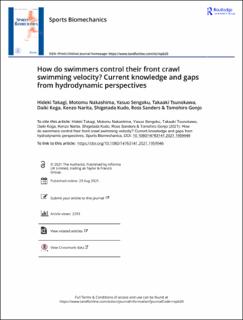| dc.contributor.author | Takagi, Hideki | |
| dc.contributor.author | Nakashima, Motomu | |
| dc.contributor.author | Sengoku, Yasuo | |
| dc.contributor.author | Tsunokawa, Takaaki | |
| dc.contributor.author | Koga, Daiki | |
| dc.contributor.author | Narita, Kenzo | |
| dc.contributor.author | Kudo, Shigetada | |
| dc.contributor.author | Sanders, Ross | |
| dc.contributor.author | Gonjo, Tomohiro | |
| dc.date.accessioned | 2022-03-22T20:46:21Z | |
| dc.date.available | 2022-03-22T20:46:21Z | |
| dc.date.created | 2022-01-26T10:18:21Z | |
| dc.date.issued | 2021 | |
| dc.identifier.citation | Sports Biomechanics. 2021, Artikkel 1959946. | en_US |
| dc.identifier.issn | 1476-3141 | |
| dc.identifier.uri | https://hdl.handle.net/11250/2986913 | |
| dc.description | This is an Open Access article distributed under the terms of the Creative Commons Attribution-NonCommercial-NoDerivatives License (http://creativecommons.org/licenses/by-nc-nd/4.0/), which permits non-commercial re-use, distribution, and reproduction in any medium, provided the original work is properly cited, and is not altered, transformed, or built upon in any way. | en_US |
| dc.description.abstract | The aim of this study was to review the literature on front crawl swimming biomechanics, focusing on propulsive and resistive forces at different swimming velocities. Recent studies show that the resistive force increases in proportion to the cube of the velocity, which implies that a proficient technique to miminise the resistive (and maximise the propulsive) force is particularly important in sprinters. To increase the velocity in races, swimmers increase their stroke frequency. However, experimental and simulation studies have revealed that there is a maximum frequency beyond which swimmers cannot further increase swimming velocity due to a change in the angle of attack of the hand that reduces its propulsive force. While the results of experimental and simulation studies are consistent regarding the effect of the arm actions on propulsion, the findings of investigations into the effect of the kicking motion are conflicting. Some studies have indicated a positive effect of kicking on propulsion at high swimming velocities while the others have yielded the opposite result. Therefore, this review contributes to knowledge of how the upper-limb propulsion can be optimised and indicates a need for further investigation to understand how the kicking action can be optimised in front crawl swimming. | en_US |
| dc.language.iso | eng | en_US |
| dc.subject | computer simulation | en_US |
| dc.subject | fluid force | en_US |
| dc.subject | optimum stroke frequency | en_US |
| dc.subject | propelling efficiency | en_US |
| dc.subject | stroke technique | en_US |
| dc.title | How do swimmers control their front crawl swimming velocity?: Current knowledge and gaps from hydrodynamic perspectives | en_US |
| dc.type | Peer reviewed | en_US |
| dc.type | Journal article | en_US |
| dc.description.version | publishedVersion | en_US |
| dc.rights.holder | © 2021 The Author(s) | en_US |
| dc.source.pagenumber | 20 | en_US |
| dc.source.journal | Sports Biomechanics | en_US |
| dc.identifier.doi | 10.1080/14763141.2021.1959946 | |
| dc.identifier.cristin | 1990167 | |
| dc.description.localcode | Institutt for fysisk prestasjonsevne / Department of Physical Performance | en_US |
| dc.source.articlenumber | 1959946 | en_US |
| cristin.ispublished | true | |
| cristin.fulltext | original | |
| cristin.qualitycode | 1 | |
